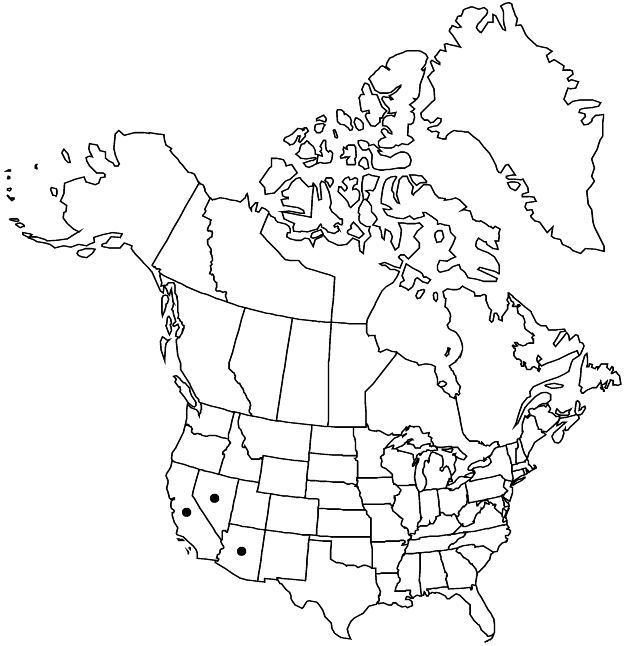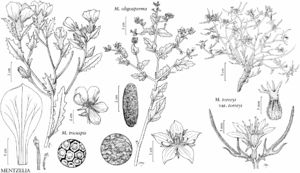Difference between revisions of "Mentzelia tricuspis"
Amer. Naturalist 9: 271. 1875.
FNA>Volume Importer |
FNA>Volume Importer |
||
| Line 31: | Line 31: | ||
|elevation=150–1300 m. | |elevation=150–1300 m. | ||
|distribution=Ariz.;Calif.;Nev. | |distribution=Ariz.;Calif.;Nev. | ||
| − | |discussion=<p>Mentzelia tricuspis is morphologically most similar to M. tridentata with differences largely limited to the lengths of the stamen filament lobes (and thus relative lengths of the anther stalks) and shapes of the seeds. However, the species are also distinct geographically, with M. tricuspis found in the southeastern Mojave Desert and northwestern Sonoran Desert and M. tridentata in the central to western Mojave Desert.</p> | + | |discussion=<p><i>Mentzelia tricuspis</i> is morphologically most similar to <i>M. tridentata</i> with differences largely limited to the lengths of the stamen filament lobes (and thus relative lengths of the anther stalks) and shapes of the seeds. However, the species are also distinct geographically, with <i>M. tricuspis</i> found in the southeastern Mojave Desert and northwestern Sonoran Desert and <i>M. tridentata</i> in the central to western Mojave Desert.</p> |
|tables= | |tables= | ||
|references= | |references= | ||
| Line 55: | Line 55: | ||
|publication year=1875 | |publication year=1875 | ||
|special status=Selected by author to be illustrated;Endemic | |special status=Selected by author to be illustrated;Endemic | ||
| − | |source xml=https://jpend@bitbucket.org/aafc-mbb/fna-data-curation.git/src/ | + | |source xml=https://jpend@bitbucket.org/aafc-mbb/fna-data-curation.git/src/8f726806613d60c220dc4493de13607dd3150896/coarse_grained_fna_xml/V12/V12_842.xml |
|genus=Mentzelia | |genus=Mentzelia | ||
|section=Mentzelia sect. Bicuspidaria | |section=Mentzelia sect. Bicuspidaria | ||
Revision as of 14:50, 18 September 2019
Plants 5–30 cm. Basal leaves: petioles present; blade lanceolate, to 12 cm; margins shallowly lobed, lobes rounded. Cauline leaves: petioles usually present, rarely absent; blade broadly ovate to lanceolate, to 12 cm, base not cordate-clasping, margins dentate to serrate. Bracts green, inconspicuous, not concealing pedicel, ovary, or capsule. Flowers: petals white to pale yellow, obovate, 10–30(–50) mm, apex mucronate; stamens 7–17 mm, less than 1/2 petal length, all fertile, none petaloid (flowers appearing to have 5 petals); filaments ± monomorphic, linear, distally 2-lobed, lobes 0.6–2.5 mm; anther stalk usually shorter than filament lobes; style 10–15 mm. Capsules cylindric to ovoid, 9–18(–23) × 5–8 mm, proximal nodding, distal erect. Seeds constricted and grooved at middle; seed coat anticlinal cell walls straight to slightly wavy, conspicuous. 2n = 20.
Phenology: Flowering Mar–May.
Habitat: Sandy or gravelly slopes, washes, desert scrub.
Elevation: 150–1300 m.
Distribution

Ariz., Calif., Nev.
Discussion
Mentzelia tricuspis is morphologically most similar to M. tridentata with differences largely limited to the lengths of the stamen filament lobes (and thus relative lengths of the anther stalks) and shapes of the seeds. However, the species are also distinct geographically, with M. tricuspis found in the southeastern Mojave Desert and northwestern Sonoran Desert and M. tridentata in the central to western Mojave Desert.
Selected References
None.
